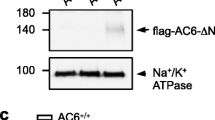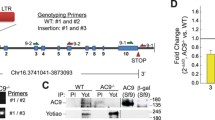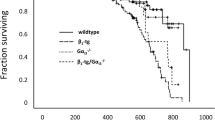Abstract
We tested the hypothesis that deletion of adenylyl cyclase type V (ACV) would be associated with decreased left ventricular (LV) contractile function and responsiveness to β–adrenergic receptor (βAR) stimulation. Absence of cardiac ACV expression was confirmed by RT–PCR and immunoblotting in ACV–deleted mice (ACV -/-). Compared to sibling mice with normal amounts of ACV (CON), basal and water–soluble forskolin derivative NKH477–stimulated cAMP production was reduced in both LV homogenates and in isolated cardiac myocytes. Basal LV +dP/dt (isolated perfused hearts) was increased (CON: 3649 ± 247 mmHg/s; ACV -/-: 4625 ± 350 mmHg/s; p = 0.035, n = 10), but the potency of dobutamine on LV +dP/dt was decreased by ACV deletion (log EC50: CON: –6.83 ± 0.14 M; ACV -/-: –5.99 ± 0.15 M; p = 0.0007, n = 10). The initial rates of ATP–dependent sarcoplasmic reticulum calcium uptake, assessed in LV homogenates, showed that ACV deletion increased SERCA2a affinity for Ca2+ (log EC50: CON: –5.94 ± 0.03 M; ACV -/-: –6.09 ± 0.02 M; p = 0.001, n = 8). ACV deletion is also associated with increased phospholamban phosphorylation, decreased type 1 protein phosphatase catalytic subunit content and activity, and reduced cardiac Gαs protein content. In conclusion, ACV deletion has a favorable effect on basal LV function despite reduced cAMP levels. Increased SERCA2a affinity for Ca2+ and increased phospholamban phosphorylation are contributing factors. However, ACV deletion is associated with reduced LV contractile responsiveness to βAR stimulation, an effect that is associated with reduced Gαs protein content and reduced cAMP generating capacity in cardiac myocytes.
Similar content being viewed by others
References
Birnbaumer L, Rodbell M (1969) Adenyl cyclase in fat cells. II. Hormone receptors. J Biol Chem 244:3477–3482
Brittsan AG, Carr AN, Schmidt AG, Kranias EG (2000) Maximal inhibition of SERCA2a Ca2+ affinity by phospholamban in transgenic hearts overexpressing a non-phosphorylatable form of phospholamban. J Biol Chem 275:12129–12135
Carr AN, Schmidt AG, Suzuki Y, Del Monte F, Sato Y, Lanner C, Breeden K, Jing SL, Allen PB, Greengard P, Yatani A, Hoit BD, Grupp IL, Hajjar RJ, DePaoli-Roach AA, Kranias EG (2002) Type 1 phosphatase, a negative regulator of cardiac function. Mol Cell Biol 22:4124–4135
Chen Z, Nield HS, Sun H, Barbier A, Patel TB (1995) Expression of type V adenylyl cyclase is required for epidermal growth factor-mediated stimulation of cAMP accumulation. J Biol Chem 270:27525–27530
Cohen P (1991) Classi.cation of proteinserine/ threonine phosphatases: identi.- cation and quantitation in cell extracts. Methods Enzymol 201:389–399
Davare MA, Avdonin V, Hall DD, Peden EM, Burette A, Weinberg RJ, Horne MC, Hoshi T, Hell JW (2001) A β2 adrenergic receptor signaling complex assembled with the Ca2+ channel Cav1.2. Science 293:98–101
Fauser C Schimanski S, Wangemann P (2004) Localization of β1-adrenergic receptors in the cochlea and vestibular labyrinth. J Membrane Biol 201:25–32
Gao MH, Lai NC, Roth DM, Zhou J, Zhu J, Anzai T, Dalton N, Hammond HK (1999) Adenylylcyclase increases responsiveness to catecholamine stimulation in transgenic mice. Circulation 99:1618–1622
Gergs U, Boknik P, Buchwalow I, Fabritz L, Matus M, Justus I, Hanske G, Schmitz W, Neumann J (2004) Overexpression of the catalytic subunit of protein phosphatase 2A impairs cardiac function. J Biol Chem 279:40827–40834
Hammond HK, Roth DA, Ford CE, Stamnas GW, Ziegler MG, Ennis C (1992) Myocardial adrenergic denervation supersensitivity depends on a postreceptor mechanism not linked with increased cAMP production. Circulation 85:666–679
Hanoune J, Defer N (2001) Regulation and role of adenylyl cyclase isoforms. Ann Rev Pharmacol Toxicol 41:145–174
Ishikawa Y, Sorota S, Kiuchi K, Shannon RP, Komamura K, Katsushika S, Vatner DE, Vatner SF, Homcy CJ (1994) Downregulation of adenylylcyclase types V and VI mRNA levels in pacing-induced heart failure in dogs. J Clin Invest 93:2224–2229
Kadambi VJ, Ponniah S, Harrer JM, Hoit BD, Dorn GW II, Walsh RA, Kranias EG (1996) Cardiac-specific overexpression of phospholamban alters calcium kinetics and resultant cardiomyocyte mechanics in transgenic mice. J Clin Invest 97:533–539
Laemmli UK (1970) Cleavage of structural proteins during the assembly of the head of bacteriophage T4. Nature 227:680–685
Lai NC, Roth DM, Gao MH, Tang T, Dalton N, Lai YY, Spellman M, Clopton P, Hammond HK (2004) Intracoronary adenovirus encoding adenylyl cyclase VI increases left ventricular function in heart failure. Circulation 110:330–336
Lee KW, Hong JH, Choi IY, Che Y, Lee JK, Yang SD, Song CW, Kang HS, Lee JH, Noh JS, Shin HS, Han PL (2002) Impaired D2 dopamine receptor function in mice lacking type 5 adenylyl cyclase. J Neurosci 22:7931–7940
Little WC (2001) Assessment of normal and abnormal cardiac function. In: Braunwald E, Zipes DP, Libby P (eds) Heart Diseases: A Textbook of Cardiovascular Medicine (Sixth Edition). Saunders Press, Philadelphia, PA, pp 479–502
Liu FC, Wu GC, Hsieh ST, Lai HL, Wang HF, Wang TW, Chern Y (1998) Expression of type VI adenylyl cyclase in the central nervous system: implication for a potential regulator of multiple signals in different neurotransmitter systems. FEBS Lett 436:92–98
Luo W, Grupp IL, Harrer J, Ponniah S, Grupp G, Duffy JJ, Doetschman T, Kranias EG (1994) Targeted ablation of the phospholamban gene is associated with markedly enhanced myocardial contractility and loss of β-agonist stimulation. Circ Res 75:401–409
MacKintosh C, Moorhead G (1999) Assay and puri.cation of protein (serine/threonine) phosphatases. In: Hardie DG (ed) Protein Phosphorylation: A Practical Approach (Second Edition). Oxford University Press, New York, NY, pp 153–181
MacLennan DH, Kranias EG (2003) Phospholamban: a crucial regulator of cardiac contractility. Nat Rev Mol Cell Biol 4:566–577
Neumann J (2002) Altered phosphatase activity in heart failure, influence on Ca2+ movement. Basic Res Cardiol 97 (Suppl 1):I91–I95
Okumura S, Kawabe J, Yatani A, Takagi G, Lee MC, Hong C, Liu J, Takagi I, Sadoshima J, Vatner DE, Vatner SF, Ishikawa Y (2003) Type 5 adenylyl cyclase disruption alters not only sympathetic but also parasympathetic and calciummediated cardiac regulation. Circ Res 93:364–371
Okumura S, Takagi G, Kawabe J, Yang G, Lee MC, Hong C, Liu J, Vatner DE, Sadoshima J, Vatner SF, Ishikawa Y (2003) Disruption of type 5 adenylyl cyclase gene preserves cardiac function against pressure overload. Proc Natl Acad Sci USA 100:9986–9990
Palakodeti V, Oh S, Oh BH, Mao L, Hongo M, Peterson KL, Ross J Jr (1997) Forcefrequency effect is a powerful determinant of myocardial contractility in the mouse. Am J Physiol 273:H1283–H1290
Papaioannou V, Johnson R (2000) Production of chimeras by blastocyst and morula injection of targeted ES cells. In: Joyner AL (ed) Gene Targeting: A Practical Approach (Second Edition). Oxford University Press, New York, NY, pp 170–171
Ping P, Anzai T, Gao M, Hammond HK (1997) Adenylylcyclase and G protein receptor kinase expression during the development of heart failure. Am J Physiol 273:H707–H717
Ross J Jr (1998) Adrenergic regulation of the force-frequency effect. Basic Res Cardiol 93 (Suppl 1):95–101
Roth DM, Bayat H, Drumm JD, Gao MH, Swaney JS, Ander A, Hammond HK (2002) Adenylyl cyclase increases survival in cardiomyopathy. Circulation 105:1989–1994
Roth DM, Gao MH, Lai NC, Drumm J, Dalton N, Zhou JY, Zhu J, Entrikin D, Hammond HK (1999) Cardiac-directed adenylyl cyclase expression improves heart function in murine cardiomyopathy. Circulation 99:3099–3102
Tang T, Gao MH, Roth DM, Guo T, Hammond HK (2004) Adenylyl cyclase type VI corrects cardiac sarcoplasmic reticulum calcium uptake defects in cardiomyopathy. Am J Physiol 287: H1906–H1912
Tepe NM, Liggett SB (1999) Transgenic replacement of type V adenylyl cyclase identifies a critical mechanism of β- adrenergic receptor dysfunction in the Gαq overexpressing mouse. FEBS Lett 458:236–240
Tobise K, Ishikawa Y, Holmer SR, Im MJ, Newell JB, Yoshie H, Fujita M, Susannie EE, Homcy CJ (1994) Changes in type VI adenylyl cyclase isoform expression correlate with a decreased capacity for cAMP generation in the aging ventricle. Circ Res 74:596–603
Author information
Authors and Affiliations
Corresponding author
Rights and permissions
About this article
Cite this article
Tang, T., Lai, N.C., Roth, D.M. et al. Adenylyl cyclase type V deletion increases basal left ventricular function and reduces left ventricular contractile responsiveness to β–adrenergic stimulation. Basic Res Cardiol 101, 117–126 (2006). https://doi.org/10.1007/s00395-005-0559-y
Received:
Revised:
Accepted:
Published:
Issue Date:
DOI: https://doi.org/10.1007/s00395-005-0559-y




